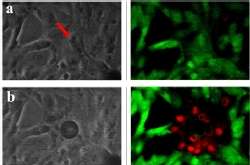Study magnetizes carbon nanoparticles for cancer therapy

(PhysOrg.com) -- A team of University of Texas at Arlington researchers have developed a method that uses magnetic carbon nanoparticles to target and destroy cancer cells through laser therapy - a treatment they believe could be effective in cases of skin and other cancers without damaging surrounding healthy cells.
A paper about the work by Ali R. Koymen, professor of physics, and Samarendra Mohanty, assistant professor of physics, was published in January’s edition of the Journal of Biomedical Optics.
Ling Gu and Vijayalakshmi Vardarajan, two post-doctoral researchers in Mohanty’s lab, were coauthors on the paper “Magnetic-field-assisted photothermal therapy of cancer cells using Fe-doped carbon nanoparticles.”
“Because these nanoparticles are magnetic, we can use an external magnetic field to focus them on the cancer cells. Then, we use a low-power laser to heat them and destroy the cells beneath,” Koymen said. “Since only the carbon nanoparticles are affected by the laser, the method leaves the healthy tissue unharmed and it is non-toxic.”
Koymen, Mohanty and R.P. Chaudhary, a student in the UT Arlington College of Engineering, developed a way of creating nanoparticles using an electric plasma discharge inside a benzene solution. A paper on that discovery was published in December in the Journal of Nanoscience and Nanotechnology.
Carbon nanoparticles produced for the cancer study varied from five to 10 nanometers wide. A human hair is about 100,000 nanometers wide.
Mohanty said the carbon nanoparticles can be coated to make them attach to cancer cells once they are positioned in an organ by the magnetic field. He said the new method has several advantages over current technology and could be administered using fiber optics inside the body.
“By using the magnetic field, we can make sure the carbon nanonparticles are not excreted until the near-infrared laser irradiation is finished. They are also crystalline and smaller than carbon nanotubes, which makes for less cell toxicity,” he said.
The magnetic carbon nanoparticles also are fluorescent. So they can be used to enhance contrast of optical imaging of tumors along with that of MRI, Mohanty said.
Mohanty said lab tests also showed that the carbon nanoparticles and a cw (continuous wave) near-infrared laser beam could be used to put a hole in the cell, revealing another potential medical use.
“Without killing the cell we can heat it up a little bit and deliver drugs and genes to the cell using low power cw near-infrared laser beam. This is an additional important novelty of our photothermal approach with carbon nanoparticles,” he said.
Provided by University of Texas at Arlington

















